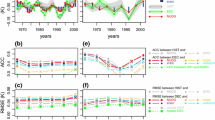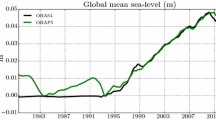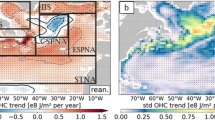Abstract
This study investigates the role of different areas of the ocean in driving the climate variability. The impact of both global and regional ocean nudging on the climate reconstruction obtained with the climate model EC-Earth v2.3 is studied over the period 1960–2012. Ocean temperature and salinity below the mixed layer are relaxed toward the monthly averages from the ORAS4 ocean reanalysis. Three coupled ocean–atmosphere simulations are considered: (1) global ocean nudging, (2) nudging in the global upper ocean (above 2000 m) and (3) nudging in the mid-latitude ocean and at full ocean depth. The experimental setup allows for identifying local and remote effects of nudging on different geographical areas. The validation is based on the correlation coefficients and the root mean square error skill score and concerns the following variables: ocean heat content, ocean barotropic streamfunction, intensity of the ocean gyres and indexes of convection, sea ice extension, near-surface air and sea surface temperature, and El Niño–Southern Oscillation 3.4 index. The results can be summarized as follows: (1) the positive impact on the reconstruction of the ocean state is found almost everywhere and for most of the analyzed variables, including unconstrained variables and/or regions, (2) deep-ocean nudging shows low impact on sea-surface temperature but a significant impact on the ocean circulation, (3) mid-latitude ocean nudging shows systematically the worst performance pointing at the importance of the poles and tropics in reconstructing the global ocean.








Similar content being viewed by others
References
Auroux D, Blum J (2008) A nudging-based data assimilation method: the back and forth nudging (BFN) algorithm. Nonlinear Process Geophys 15:305–319
Balmaseda M, Mogensen K, Weaver A (2013) Evaluation of the ECMWF ocean reanalysis system ORAS4. Q J R Meteorol Soc 139:1132–1161. doi:10.1002/qj.2063
Booth B, Dunstone N, Halloran P, Andrews T, Bellouin N (2012) Aerosols implicated as a prime driver of twentieth-century north atlantic climate variability. Nature 484:228–232
Brodeau L, Barnier B, Treguier AM, Penduff T, Gulev S (2010) An ERA40-based atmospheric forcing for global ocean circulation models. Ocean Model 31:88–104
Carrassi A, Weber R, Guemas V, Doblas-Reyes F, Asif M, Volpi D (2014) Full-field and anomaly initialization using a low-order climate model: a comparison and proposals for advanced formulations. Nonlinear Process Geophys 21:521–537
Challinor A, Slingo J, Wheeler T, DoblasReyes F (2005) Probabilistic simulations of crop yield over western india using the demeter seasonal hindcast ensembles. Tellus A 57(3):498–512. doi:10.1111/j.1600-0870.2005.00126.x
Daron JD (2012) Examining the decision-relevance of climate model information for the insurance industry. Ph.D. thesis, The London School of Economics and Political Science
Doblas-Reyes F, Andreu-Burillo I, Chikamoto Y, Garca-Serrano J, Guemas V, Kimoto M, Mochizuki T, Rodrigues L, van Oldenborgh G (2013a) Initialized near-term regional climate change prediction. Nat Commun 4:1715
Doblas-Reyes F, García-Serrano J, Lienert F, Biescas AP, Rodrigues L (2013b) Seasonal climate predictability and forecasting: status and prospects. WIREs Clim Change 4:245–268
Doblas-Reyes FJ, Balmaseda MA, Weisheimer A, Palmer TN (2011) Decadal climate prediction with the European Centre for Medium Range Weather Forecasts coupled forecast system: impact of ocean observations. J Geophys Res. doi:10.1029/2010JD015394
Dunstone N, Smith D (2010) Impact of atmosphere and subsurface ocean data on decadal climate prediction. Geophys Res Lett 37(L02):709
Ethe C, Aumont O, Foujols MA, Levy M (2006) NEMO reference manual, tracer component: NEMO-TOP. Preliminary version. Note du Pole de modélisation, Institut Pierre-Simon Laplace (IPSL). France 28:1288–1619
Fan Y, van den Dool H (2008) A global monthly land surface air temperature analysis for 1948-present. J Geophys Res. doi:10.1029/2007JD008470
Fichefet T, Maqueda MAM (1997) Sensitivity of a global sea ice model to the treatment of ice thermodynamics and dynamics. J Geophys Res 102:12,609–12,646
García-Morales M, Dubus L (2007) Forecasting precipitation for hydroelectric power management: how to exploit GCM’s seasonal ensemble forecasts. Int J Climatol 12(27):1691–1705. doi:10.1002/joc.1608
Germe A, Chevallier M, y Mélia DS, Sanchez-Gomez E (2014) Interannual predictability of arctic sea ice in a global climate model: regional contrasts and temporal evolution. Clim Dyn. doi:10.1007/s00382-014-2071-2
Goosse H, Fichefet T (1999) Importance of ice-ocean interactions for the global ocean circulation: a model study. J Geophys Res 104:23,337–23,355
Guemas V, Doblas-Reyes F, Mogensen K, Tang Y, Keeley S (2014) Ensemble of sea ice initial conditions for interannual climate predictions. Clim Dyn 43:2813–2829. doi:10.1007/s00382-014-2095-7
Hansen J, Ruedy R, Sato M, Lo K (2010) Global surface temperature change. Rev Geophys. doi:10.1029/2010RG000345
Hawkins E, Sutton R (2009) The potential to narrow uncertainty in regional climate predictions. Bull Am Meteorol Soc 90:1095–1107
Hazeleger W, Wang X, Severijns C, Stefanescu S, Bintanja R, Sterl A, Wyser K, Semmler T, Yang S, van den Hurk B (2012) EC-Earth V2.2: description and validation of a new seamless Earth system prediction model. Clim Dyn. doi:10.1007/s00382-011-1228-5
Hazeleger W, Guemas V, Wouters B, Corti S, Andreu-Burillo I, Doblas-Reyes F, Wyser K, Caian M (2013) Multiyear climate predictions using two initialization strategies. Geophys Res Lett. doi:10.1002/grl.50355
Hoke J, Anthes R (1976) The initialization of numerical models by a dynamic-initialization technique. Mon Weather Rev 104:1551–1556
Ide K, Courtier P, Ghil M, Lorenc AC (1997) Unified notation for data assimilation: operational, sequential and variational. J Meteorol Soc Jpn 75(1B):181–189
Kalnay E (2002) Atmospheric modeling, data assimilation, and predictability. Cambridge University Press, Cambridge
Keenlyside NS, Latif M, Jungclaus J, Kornblueth L, Roeckner E (2008) Advancing decadal-scale climate prediction in the North Atlantic sector. Nature 453:84–88. doi:10.1038/nature06921
Kröger J, von Storch WMJS (2012) Impact of different ocean reanalyses on decadal climate prediction. Clim Dyn 39:795–810. doi:10.1007/s00382-012-1310-7
Lakshmivarahan S, Lewis J (2012) Data assimilation for atmospheric, oceanic and hydrological applications, vol 2. Springer, Berlin. doi:10.1007/978-3-642-35088-7_2
Latif M, Collins M, Pohlmann H, Keenlyside N (2006) A review of predictability studies of atlantic sector climate on decadal time scales. J Clim 19:5971–5987
Lei L, Stauffer D, Haupt S, Young G (2012) A hybrid nudging-ensemble kalman filter approach to data assimilation. part II: application in a shallow-water model. Tellus A 64:18485
Madec G (2008) NEMO ocean engine. Note du Pole de modélisation, Institut Pierre-Simon Laplace (IPSL), France 27:1288–1619
Magnusson L, Alonso-Balmaseda M, Corti S, Molteni F, Stockdale T (2013) Evaluation of forecast strategies for seasonal and decadal forecasts in presence of systematic model errors. Clim Dyn 41:2393–2409. doi:10.1007/s00382-012-1599-2
Meehl G et al (2013) Decadal climate prediction: an update from the trenches. Bull Am Meteorol Soc 95(95):243–267. doi:10.1175/BAMS-D-12-00241.1
Meehl GA, Goddard L, Murphy J, Stouffer RJ, Boer G, Danabasoglu G, Dixon K, Giorgetta MA, Greene AM, Hawkins E, Hegerl G, Karoly D, Keenlyside N, Kimoto M, Navarra BKA, Pulwarty R, Smith D, Stammer D, Stockdale T (2009) Decadal prediction. Bull Am Meteorol Soc 90(10):1467–1485
Mochizuki T, Ishii M, Kimoto M, Chikamoto Y, Watanabe M, Nozawa T, Sakamoto TT, Shiogama H, Awaji T, Sugiura N, Toyoda T, Yasunaka S, Tatebe H, Mori M (2010) Pacific decadal oscillation hindcasts relevant to near-term climate prediction. PNAS 107:1833–1837. doi:10.1073/pnas.0906531107
Mogensen K, Balmaseda M, Weaver A (2012) The NEMOVAR ocean data assimilation system as implemented in the ECMWF ocean analysis for system 4. Tech Mem ECMWF 668
Murphy J, Kattsov V, Keenlyside N, Kimoto M, Meehl G, Mehtaf V, Pohlmann H, Scaife A, Smith D (2010) Towards prediction of decadal climate variability and change. Proc Environ Sci 1:287–304
van Oldenborgh G, Doblas-Reyes F, Wouters B, Hazeleger W (2012) Skill in the trend and internal variability in a multi-model decadal prediction ensemble. Clim Dyn 38:1263–1280
Pohlmann H, Jungclaus JH, Kohl A, Stammer D, Marotzke J (2009) Initializing decadal climate predictions with the GECCO oceanic synthesis: effects on the North Atlantic. J Clim 22:3926–3938
Polkova I, Köhl A, Stammer D (2014) Impact of initialization procedures on the predictive skill of a coupled ocean atmosphere model. Clim Dyn 42:3151–3169. doi:10.1007/s00382-013-1969-4
Rayner N, Brohan P, Parker D, Folland C, Kennedy J, Vanicek M, Ansell T, Tett S (2006) Improved analyses of changes and uncertainties in sea surface temperature measured in situ since the mid-nineteenth century: the HADSST2 data set. J Clim 19(13):446–469
Sanchez-Gomez E, Cassou C, Ruprich-Robert Y, Fernandez E, Terray L (2015) Drift dynamics in a coupled model initialized for decadal forecasts. Clim Dyn. doi:10.1007/s00382-015-2678-y
Smith D, Murphy J (2007) An objective ocean temperature and salinity analysis using covariances from a global model. J Geophys Res 112(C02):022. doi:10.1029/2005JC003172
Smith D, Cusack A, Colman A, Folland C, Harris G, Murphy J (2007) Improved surface temperature prediction for the coming decade from a global climate model. Science 317:796–799. doi:10.1126/science.1139540
Smith D, Eade R, Pohlmann H (2013) A comparison of full-field and anomaly initialization for seasonal to decadal climate prediction. Clim Dyn 41:3325–3338. doi:10.1007/s00382-0131683-2
Smith TM, Reynolds RW, Lawrimore TCPH (2008) Improvements to NOAA’s historical merged land–ocean surface temperature analysis (1880–2006). J Clim 21:2283–2296
Taylor KE, Stouffer RJ, Meehl GA (2011) An overview of CMIP5 and the experimental design. Bull Am Meteorol Soc. doi:10.1175/BAMS-D-11-00094.1
Thompson M, Doblas-Reyes F, Mason S, Hagedorn R, Connor S, Phindela T, Morse A, Palmer T (2006) Malaria early warnings based on seasonal climate forecasts from multi-model ensembles. Nature 439:576–579. doi:10.1038/nature04503
Uppala S, Kallberg P, Simmons A, Andrae U, Bechtold V, Fiorino M, Gibson J, Haseler J, Hernandez A, Kelly G, Li X, Onogi K, Saarinen S, Allan NSR, Andersson E, Arpe K, Balmaseda M, Beljaars A, Berg L, Bormann JBN, Caires S, Chevallier F, Dethof A, Dragosavac M, Fisher M, Fuentes M, Hagemann S, Hoskins EHB, Isaksen L, Janssen P, Jenne R, Mcnally A, Mahfouf JF, Morcrette JJ, Rayner N, Saunders R, Simon P, Sterl A, Trenberth K, Untch A, Vasiljevic D, Viterbo P, Woollen J (2005) The ERA-40 reanalysis. Q J R Meteorol Soc 131:2961–3012
Valcke S (2013) The OASIS3 coupler: a European climate modelling community software. Geosci Model Dev 6:373–388. doi:10.5194/gmd-6-373-2013
Weber R, Carrassi A, Doblas-Reyes F (2015) Linking the anomaly initialization approach to the mapping paradigm: a proof-of-concept study. Mon Weather Rev 143:4695–4713
Acknowledgments
A. Carrassi was financed through the IEF Marie Curie Project INCLIDA of the FP7. This work was supported by the EU-funded SPECS (FP7-ENV-2012- 308378), the MINECO-funded PICA-ICE (CGL2012-31987) Projects, and EU-FP7 Project SANGOMA under Grant Agreement No. 283580.
Author information
Authors and Affiliations
Corresponding author
Rights and permissions
About this article
Cite this article
Carrassi, A., Guemas, V., Doblas-Reyes, F.J. et al. Sources of skill in near-term climate prediction: generating initial conditions. Clim Dyn 47, 3693–3712 (2016). https://doi.org/10.1007/s00382-016-3036-4
Received:
Accepted:
Published:
Issue Date:
DOI: https://doi.org/10.1007/s00382-016-3036-4




